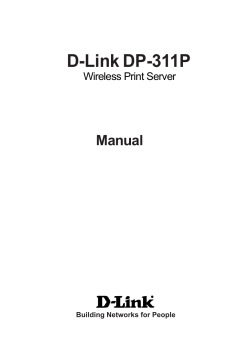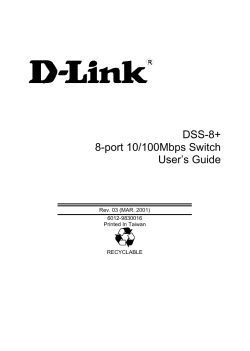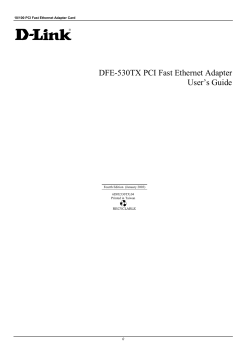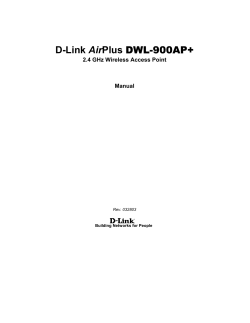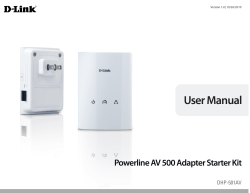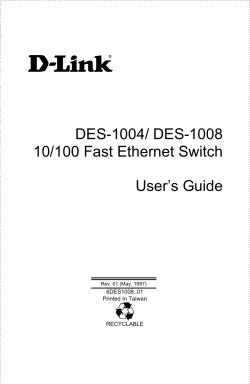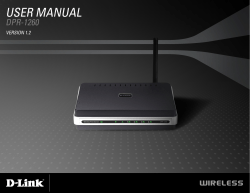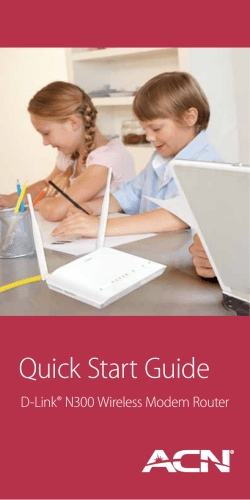
D-Link DP-301P+ Manual Pocket Size Print Server Building Networks for People
D-Link DP-301P+ Pocket Size Print Server Manual Building Networks for People Contents Package Contents ................................................................................3 Introduction............................................................................................4 Setting up the DP-301P+ ......................................................................8 Getting Started ....................................................................................10 Using the Web Configuration ............................................................... 11 TCP/IP Printing for Windows XP .........................................................18 TCP/IP Printing for Windows 2000 ......................................................26 TCP/IP Printing for Windows 98SE/Me ...............................................34 Unix/Linux Printing ...............................................................................45 Setting up AppleTalk or LPR Printing in MAC OS X .............................46 Setting up AppleTalk Printing in MAC OS 9 .........................................51 Networking Basics ..............................................................................54 Technical Specifications ......................................................................66 Contacting Technical Support ..............................................................67 Warranty..............................................................................................68 Registration ........................................................................................71 Appendix: DP-301P+ Printer Compatibility List ..................................72 2 Package Contents Contents of Package: D-Link DP-301P+ Pocket Size Print Server Manual and Warranty on CD Printed Quick Installation Guide If any of the above items are missing, please contact your reseller. System Requirements: A computer with an installed Ethernet adapter Windows XP/2000/NT4/Me/98SE Apple Mac OS with AppleTalk Linux NetWare 5.x (Native NDS) Internet Explorer 6.0, or Netscape Navigator version 6.0 or above, with JavaScript enabled Printer must support required Operating System 3 Introduction The D-Link DP-301P+ Print Server is a pocket size print server that connects to your Ethernet/Fast Ethernet network anywhere you wish to locate printer services. The DP-301P+ manages the flow of print files from workstations or file servers to connected printers, delivering print jobs to printers much faster than a file server or a PC acting as a print server. The DP-301P+ includes easy-to-use software to install on most Windows-based networks. Protocol support for TCP/IP, NetBEUI, and AppleTalk are provided to ensure seamless connection to major networking operating systems. The DP-301P+ has a built in Web-based management feature that allows users to easily configure and manage multiple print queues through TCP/IP. The DP-301P+ also supports Telnet as an alternative method to configure the unit. The DP-301P+ improves network printing services in the following ways: The DP-301P+ manages print file traffic. This provides workload relief to your file servers, and allows the file servers’ full capacity to be used for file access or other direct services to network users. On Peer-toPeer networks, workstations can print directly to the print server without increasing the load of another workstation or server. Because the DP-301P+ is very portable and inexpensive compared to a PC-based print server, and the print server connects to your file servers through the network, printers can be deployed to locations of maximum convenience to users. 4 The DP-301P+ offers extraordinary flexibility, operating with all major network operating systems and protocols: TCP/IP UNIX LPR/LPD (HP-UX, Sun OS, Solaris, SCO, UnixWare, IBM AIX) Windows NT/2000, Windows 95/98SE/Me, Windows XP NetWare 5.x NDPS LPR Remote Printing NetBEUI Windows NT/2000/XP, Windows 95/98SE/Me, Windows for Workgroups, Microsoft LAN Manager, IBM LAN Server AppleTalk Mac OS EtherTalk Windows-based setup and administration software, PS Admin, is supplied with the print server, making configuration and management quick and easy. The print server also supports configuration and management via the Telnet protocol for networks without Windows-compatible machines. External Features Port Connectors The DP-301P+’s parallel port is located on its front panel. The port can be configured using the PS Admin program or the print server’s Telnet interface. (See the PS Admin User’s Guide, available on the CD that came with the DP-301P+, for information about configuring the print server’s ports.) The print server also supports web configuration permitting users to configure settings through the Web browser. The default IP address is as follows: Default IP address – 192.168.0.10 Subnet mask – 255.255.255.0 Note: The PC’s IP address must be in the same subnet as the print server’s IP address for the two devices to communicate. (For example, if your print server’s IP address is 192.168.0.10, with a subnet mask of 255.255.255.0, then your computer’s IP address should be 192.168.0.x, where x is a value between 1-254, excluding 10.) 5 Rear Panel LAN Port LEDs Power LAN Port - Network Cable Connector The print server’s rear panel features a LAN port for connection to Ethernet/Fast Ethernet cabling (which should be CAT5 twisted-pair cable). The port supports the NWay protocol, allowing the print server to automatically detect or negotiate the transmission speed of the network. Use this port to connect to your network router. Power - DC Power Connector The DC power input connector is located on the print server’s rear panel . LED Indicators The back panel of the print server features three LED indicators: ACT - Lights up to indicate activity on the network. LPT - Lights up to indicate printing activity. 1 - Lights up to indicate that the DP-301P+ is powered ON. 6 Front Panel Parallel Port Connector The front panel of the print server features the parallel port connector. Plug this connector directly into the parallel port on your network printer. There is no need for a parallel port cable between the print server and your network printer. 7 Setting up the DP-301P+ Installing the Print Server WARNING: Configuration problems may result if the print server is powered up without first establishing its network connection. Follow this procedure to avoid complications at the configuration stage. 1. Confirm proper operation of the printers to be connected to the DP-301P+. 2. When you have confirmed proper operation of the printer, switch its power OFF. 3. Confirm that your network is operating normally. 4. Using an Ethernet CAT5 cable, connect the DP-301P+ to the network. 5. While the printer is powered OFF, install the DP-301P+ parallel port connector into the parallel port on the network printer. 6. Switch on the connected printer. 7. Plug the power adapter into the DP-301P+’s DC 5V power socket. 8. Plug the power adapter into a power outlet. This will supply power to the print server, as it has no external power switch. The green Power LED on the Print Server’s front panel should illuminate steadily, and the Print Server’s Self-Test will proceed. Power ON Self-Test Every DP-301P+ has been factory-tested to operate properly. Whenever the DP-301P+ is powered up, two testing procedures follow automatically. The first procedure is a programmed series of flashes intended to confirm proper operation of the LED indicators. The second procedure comprises programmed tests of the DP-301P+’s internal circuitry. If any fault is found during the circuitry tests, testing stops and a continuous pattern of flashes signals the nature of the fault. 8 Indicator Test Immediately upon power-up, the 1 (Power) and LPT indicators will illuminate steadily in green for several seconds. Then the LPT indicator will become dark while the 1 (Power) indicator remains steady. Irregularity of any indicator during this test indicates that there is a problem with the indicators themselves. Circuit Tests The circuit tests immediately follow the indicator test. A normal (no fault) result is signaled by three flashes of the LPT indicator and the start of normal print server operation. If any error condition is found during the circuit tests, testing will halt with the LPT indicator continuously signaling the particular error according to the following table: LPT LED Flash Pattern Error Type Steady long flashes Firmware Reload Required Continuously on DRAM Error One long, two short flashes Timer INT error One long, three short flashes Flash Protected One long, five short flashes Flash Erase/Program error One long, six short flashes LAN Controller error One long, eight short flashes Parallel Controller Error One long, nine short flashes LPT Error One long, fourteen short flashes LAN PHY error In the event of a Firmware Reload Required error at startup, proceed according to instructions given in the PS Admin User’s Guide (“PS Admin Administration” section, under the heading “Upgrading the Print Server’s Internal Firmware”). The PS Admin software includes a Print Test function for confirmation of print server connections and functions. This operational test can be performed after you have installed the PS Admin software and completed the PS Admin procedures for configuring the DP-301P+. See the instructions given in the PS Admin Users Guide (“Getting Started Setting up Your Print Server” section, under the heading “Testing your Print Server”). 9 Getting Started Below is a sample network using the DP-301P+. The DP-301P+ has a builtin Web-based management feature that allows users to easily configure and manage multiple print queues through TCP/IP. For a list of printers that are compatible with the DP-301P+, please see the Appendix in this manual. The compatibility list is not comprehensive. Even if it is not included in the list, your printer may be compatible with the DP-301P+. 10 Using the Web Configuration Open your Web browser and type http://192.168.0.10 in the address box, and press Enter. This set of numbers is the default IP address of your print server. Please note that the PC’s IP address must correspond with the Print Server’s IP address in the same segment for the two devices to communicate. http://192.168.0.10 When you entered the default IP address, the main screen of the Print Server’s configuration will appear (see below). In addition to the product information, you can access and control the print server’s configuration through five links on the top of this main screen: Home, Configuration, Network, Tools, and Help. 11 Using the Web Configuration (continued) Home System Status and Printer Status The Home tab displays the system information, providing general information regarding the print server. Click on the Refresh button to acquire the most updated information. Once a printer is connected to the print server, the Printer Status will be displayed. Server Name: The name assigned to the print server. Model: The model of the print server. Hardware Version: The version of the hardware on the print server. Firmware Version: The version of the firmware and release date on the print server. MAC Address: The MAC address of the Ethernet port. IP Address: The IP address of the print server. Up Time: The length of time the print server has been up. 12 Using the Web Configuration (continued) Configuration The Configuration window will display the settings required to configure the DP301P+ Print Server. Consult your printer’s manual for the PJL (Printer Job Language) and print speed supported on your printer. Click Save on the bottom of the configuration page to ensure the settings are updated and saved. Server Name: The name assigned to the print server. Location: Input a comment indicating where the print server is located. (optional) Admin Contact: The name of the print server’s administrator. (optional) Password: By default the DP-301P+ does not have a password. For security, you may wish to enter a password. Port Name: This is the assigned name for the parallel port. Description: A brief description for the parallel port. (optional) Speed: Select high or low printer port speed. PJL Printer: This feature is used to support the Hewlett-Packard PJL (Printer Job Language) standard for bi-directional printing. 13 Using the Web Configuration (continued) Network 14 Using the Web Configuration (continued) Network (continued) TCP/IP Protocol IP Address: The default IP address is 192.168.0.10 Subnet Mask: The default subnet mask is 255.255.255.0 Default Gateway: Enter the IP address of the default gateway (router). IP Assignment: Manually Assign: Select this option when you manually input the IP address in the field above. Assign Automatically Using: RARP: Reverse Address Resolution Protocol is a TCP/IP protocol that assigns an IP address using MAC address information. BOOTP: Bootstrap Protocol can provide an IP address to the print server. DHCP: Dynamic Host Configuration Protocol automatically assigns an IP address to the print server. SNMP Community 1-3: Simple Network Management Protocol is a set of protocols for managing complex networks. Name: Enter a name. Access Right: Select from the pull-down menu. Read Only or Read/Write. Net BEUI Protocol Net Bios Extended User Interface is an enhanced version of the NetBios protocol that is used by many LAN managing systems. Workgroup: Enter a name for the Workgroup. Maximum Limitation: Enter the maximum number of connected stations. AppleTalk Protocol AppleTalk Zone: Enter an asterisk. Chooser Name: Enter the printer name. Printer Type: Enter the printer type. PostScript Level: Enter the PostScript level. Font Group: Enter the font group. Save: Click Save to save the changes. 15 Using the Web Configuration (continued) Tools Print Test: To print a test page, click Test. Reset: Click YES to reset the print server to its factory default settings. The print server will then restart. You will lose all the user-defined settings and you will need to reconfigure the print server. WARNING: Clicking YES in this screen will result in a complete factory reset. You will lose all the configuration settings you have made and you will need to reconfigure the settings. 16 Using the Web Configuration (continued) Help Click on the link in the window to access D-Link’s support website. D-Link’s support website will provide the most up to date information on your DP-301P+ Print Server. Please check the website regularly for product and firmware updates. 17 TCP/IP Printing for Windows XP Open the Web browser, and type in the IP address of the DP-301P+. Type http://192.168.0.10 into the Location or Address field. Press Enter. Note: The PC’s IP address must be in the same subnet as the Print Server’s IP address for the two devices to communicate. (For example, if your print server’s IP address is 192.168.0.10, with a subnet mask of 255.255.255.0, then your computer’s IP address should be 192.168.0.x, where x is a value between 1-254, excluding 10.) See Networking Basics: Assigning a Static IP Address in this manual to find out how to change an IP address. D-Link DP-301U http://192.168.0.10 18 TCP/IP Printing for Windows XP (continued) At the Configuration window, write down the Port Name for future reference. You will need this information later in the configuration process. 19 TCP/IP Printing for Windows XP (continued) When you select TCP/IP Protocol at the Network window, the screen below appears. (We recommend that you keep the default settings as shown.) If you need to make changes, make sure to click Save after you have made the changes. (You may wish to make a note of the IP address.) 20 TCP/IP Printing for Windows XP (continued) Go to Start > Settings > Printers and Faxes > Add a Printer. Click Next. 21 TCP/IP Printing for Windows XP (continued) Select Local Printer. Deselect Automatically detect and install my Plug and Play printer. Click Next. Select Create a new port. At the pull-down menu, highlight Standard TCP/IP Port. Click Next. Click Next. 22 TCP/IP Printing for Windows XP (continued) Type in the IP address of the print server (i.e. 192.168.0.10). The Port Name will automatically be filled in. Select Standard. Click Next. Click Finish. 23 TCP/IP Printing for Windows XP (continued) Highlight the printer, as shown. If the desired printer is not on the list, click Have Disk and insert the printer driver disk that came with your printer to install the printer drivers. Click Next. At this screen, you can input a name for the printer. Click Next. Click Next. 24 TCP/IP Printing for Windows XP (continued) Epson Stylus Epson Stylus COLOR 740 ESC/P2 Click Finish. 25 TCP/IP Printing for Windows 2000 Open the Web browser, and type the IP address of the DP-301P+ ( http://192.168.0.10 )into the Location or Address field. Press Enter. Note: The PC’s IP address must be in the same subnet as the print server’s IP address for the two devices to communicate. (For example, if your print server’s IP address is 192.168.0.10, with a subnet mask of 255.255.255.0, then your computer’s IP address should be 192.168.0.x, where x is a value between 1254, excluding 10.) http://192.168.0.10 26 TCP/IP Printing for Windows 2000 (continued) At the Configuration window, write down the Port Name for future reference. You will need this information later in the configuration process. 27 TCP/IP Printing for Windows 2000 (continued) When you select TCP/IP Protocol at the Network window, the screen below appears. (We recommend that you keep the default settings as shown.) If you need to make changes, make sure to click Save after you have made the changes. (You may wish to make a note of the IP address.) 28 TCP/IP Printing for Windows 2000 (continued) Go to Start > Settings > Printers Double-click on the Add Printer icon. Click Next. 29 TCP/IP Printing for Windows 2000 (continued) Select Local Printer. Click Next. Select Create a new port at the pull-down menu, highlight Standard TCP/IP Port. Click Next. 30 TCP/IP Printing for Windows 2000 (continued) Click Next. Type in the IP address of the print server in the Printer Name or IP Address field. The Port Name field will automatically be filled in. Click Next. Select Standard. Click Next. 31 TCP/IP Printing for Windows 2000 (continued) Click Finish. Highlight the printer, as shown. If the desired printer is not on the list, click Have Disk and insert the printer driver disk that came with your printer to install the printer drivers. Click Next. At this screen, you can input a name for the printer. Click Next. 32 TCP/IP Printing for Windows 2000 (continued) Select Do not share this printer. . Click Next. Select Yes to print a test page. Click Next. Click Finish. The printer is now ready for printing with Windows 2000 on your network. 33 TCP/IP Printing for Windows 98SE/Me Open the Web browser, and type the IP address of the DP-301P+ (http://192.168.0.10) into the Location or Address field. Press Enter. Note: The PC’s IP address must be in the same subnet as the print server’s IP address for the two devices to communicate. (For example, if your print server’s IP address is 192.168.0.10, with a subnet mask of 255.255.255.0, then your computer’s IP address should be 192.168.0.x, where x is a value between 1-254, excluding 10.) http://192.168.0.10 34 TCP/IP Printing for Windows 98SE/Me (continued) At the Configuration window, write down the Port Name for future reference. You will need this information later in the configuration process. The Port Name shown here is only an example. 35 TCP/IP Printing for Windows 98SE/Me(continued) When you select TCP/IP Protocol at the Network window, the screen below appears. (We recommend that you keep the default settings as shown.) If you need to make changes, make sure to click Save after you have made the changes. (You may wish to make a note of the IP address.) 36 TCP/IP Printing for Windows 98SE/Me (continued) Go to Start > Settings > Control Panel. Double-click on Network. The screen shown at the right will appear. Click Add. Highlight Client. Click Add. 37 TCP/IP Printing for Windows 98SE/Me (continued) At this window, click Have Disk. 1. Insert the DP-301P+ CD-ROM into your CD-ROM drive. Select the letter representing the CD-ROM drive on your computer from the pull-down menu. 2. Double-click on the folder lpr. 4 2 3 3. Highlight lpr.inf. 4. Click OK. 1 Click OK to accept the location of the file. 38 TCP/IP Printing for Windows 98SE/Me (continued) Click OK. You should now be back to the Network Properties Page. Highlight LPR for TCP/IP Printing. Click Properties. 39 TCP/IP Printing for Windows 98SE/Me (continued) Click Add Port. Type in the IP address of the DP-301P+. Make sure the Port Name is accurate. (The Port Name at right is just an example.) PS-116688-P1 Click OK. The Port Name and IP address will be displayed. (The Port Name at right is just an example.) 192.168.0.10/PS-116688-P1 Click OK. 40 TCP/IP Printing for Windows 98SE/Me (continued) Click OK. Windows will ask for a restart. Click Yes. 41 TCP/IP Printing for Windows 98SE/Me (continued) Once your computer has rebooted, click on Start > Settings > Printers > Add Printer When the Add Printer Wizard screen appears, click Next. Select Network Printer. Click Next. Type in the path, if you know it, or click Browse. 42 TCP/IP Printing for Windows 98SE/Me (continued) At the next screen, browse for the printer port. Highlight the port as shown. (The Port Name in this window is just an example.) PS-116688-P1 Click OK. If the network path is not specified, type in the IP address of the DP-301P+ and the Port Name. (The Port Name shown at right is just an example.) Select Yes or No, to answer the question: Do you print from MS-DOS based programs? Click Next. Highlight the printer, as shown. If the desired printer is not on the list, click Have Disk and insert the printer driver disk that came with your printer to install the printer drivers. Click Next. Click Next. 43 192.168.0.10\PS-116688-P1 TCP/IP Printing for Windows 98SE/Me (continued) Select Yes to print a test page. Click Finish. Go to Start > Settings > Printers Check to see that your printer is installed. 44 Unix/Linux Printing Please refer to the PS Admin Manual on the CD included with your DP-301P+ purchase for information on setting up the print server in Unix/Linux. 45 Setting up Apple Talk or LPR Printing in Mac OS X Note: Mac OS printing is supported by PostScript printers only! With Mac OS X you can use AppleTalk or LPR printers using IP protocols for printing through print servers. Follow the instructions below to set up the print server. After attaching the print server to your network using the directions provided in the Quick Installation Guide, change the IP address of your Macintosh to access the print server’s Web configuration. Open your System Preferences window and click Network. At the Configure pull-down menu, select Manually 46 Setting up Apple Talk or LPR Printing in Mac OS X (continued) The default IP address of the print server is 192.168.0.10. Manually change your IP address to 102.168.0.x, where x is any number between 1 and 254 (except 10 which is the IP address of the print server.) The IP addresses and subnet mask shown here are examples only. Select the AppleTalk tab in this window and check Make AppleTalk Active. 47 Setting up Apple Talk or LPR Printing in Mac OS X (continued) To print, open a document and select File > Print from the menu. Select Edit Printer List from the Printer dialog box. Click Add Printer 48 Setting up Apple Talk or LPR Printing in Mac OS X (continued) Select the printing protocol preferred, AppleTalk or LPR Printers using IP. In this example, AppleTalk has been selected. AppleTalk protocol: After selecting AppleTalk the Port Name of the print server will be displayed. The Port Name shown here is an example only. PS - 1123D6-U1 PS-116688-P1 PS-116688-P1 PS - 1123D6-U1 Laserwriter Laserwriter Click on the port to which the PostScript printer is connected. Then select the printer model from the dialog box displayed here. Click Add Printer and the printer port configuration is complete. Select the printer port just configured in the print window. Click Print to print your document. 49 Setting up Apple Talk or LPR Printing in Mac OS X (continued) LPR Printers using IP protocol: When you select LPR Printers using IP Protocol, this window will appear. Type the IP address of the print server into the LPR Printer’s Address field. PS-116688-P1 PS-1123D6 - U1 In the Queue Name field, type in the Port Name of the post-script printer that is connected to the print server. The Port Name illustrated here is only an example. Select the printer model from the dialog box. Select the printer model from the dialog box. Click Add. Close all print center windows, select the printer port that was just selected. Click Print to print the document. Click Add and the process is complete. 50 Setting up Apple Talk Printing in Mac OS 9 Note: Mac OS printing is supported for PostScript printers only! The AppleTalk network protocol is used with computers using the Macintosh operating system. It can be used for network communications over standard Ethernet or Fast Ethernet using the EtherTalk transport, or over a proprietary LocalTalk transport. Your print server can be used for network printing to PostScript printers. You can print from any Mac OS computer connected to your Ethernet network, either directly using an EtherTalk connection, or indirectly through a LocalTalk-to-EtherTalk router. NOTE: The chooser name of a printer connected to one of the print server’s ports is the same as its port name. If you are using AppleTalk printing, you will need to make sure that every port name is unique among all of the network printers in your AppleTalk zone. The port names shown in this manual are examples only. Setting up the print server for AppleTalk Printing To set up your print server so that it can be used for AppleTalk printing: Make sure the AppleTalk protocol is enabled in your Macintosh. Change the IP address on one of the computers on your network to 192.168.0.x, where x is any number between 11-254, excluding 10. Type 192.168.0.10 into the address field of your web browser. 192.168.0.10 is the default IP address of the DP-301P+. Select the Network tab and scroll to the bottom to the AppleTalk protocol section. If your AppleTalk network is divided into AppleTalk zones, you will have to specify which zone the print server should be in. You should locate the print server in the same zone as most of the users who will be using it. If your network is not divided into zones, the AppleTalk Zone field should contain a single asterisk “*”. 51 Printing from Mac OS Client Workstations The exact procedure for selecting a PostScript printer connected to your print server may vary slightly, depending on what printer driver version you are using. The procedure described below assumes you are using the LaserWriter 8. To choose a printer connected to your print server as your Mac OS workstation’s default printer, Open the chooser by selecting Chooser from the Apple menu. Select the LaserWriter 8 icon on the left. Make sure that AppleTalk is set to Active. A list of all networked PostScript printers will be displayed: Double-click the name of the printer port you wish to use. The printer ports shown are examples only. PS-116688-P1 52 Printing from Mac OS Client Workstations (continued) If you have not previously set this printer as the default, your computer will prompt you for a PostScript Printer Description file. Choose Select PPD. Select the appropriate printer description file for your printer. Click Open. (If your printer is not listed, click Generic to use a generic printer description.) Epson Stylus COLOR 740 ESC/P2 If you wish to access this setting in the future, you can use the Setup button in the Chooser window. The selected printer will become your computer’s default printer. You may need to choose Page Setup in any applications you have open. 53 Networking Basics Using the Network Setup Wizard in Windows XP In this section you will learn how to establish a network at home or work, using Microsoft Windows XP. Note: Please refer to websites such as http://www.homenethelp.com and http://www.microsoft.com/windows2000 for information about networking computers using Windows 2000, Me or 98SE. Go to Start>Control Panel>Network Connections When this screen appears, click Next. 54 Networking Basics (continued) Please follow all the instructions in this window: In this window, select the best description of your computer. If your computer connects to the Internet through a gateway/router, select the second option as shown. Click Next. 55 Networking Basics (continued) Enter a Computer description and a Computer name (optional.) Click Next. Enter a Workgroup name. All computers on your network should have the same Workgroup name. Click Next. 56 Networking Basics (continued) Please wait while the Network Setup Wizard applies the changes. When the changes are complete, click Next. Please wait while the Network Setup Wizard configures the computer. This may take a few minutes. 57 Networking Basics (continued) In this window, select the best option. In this example, Create a Network Setup Disk has been selected. You will run this disk on each of the computers on your network. Click Next. Insert a disk into the Floppy Disk Drive, in this case drive A. Format the disk if you wish, and click Next. 58 Networking Basics (continued) Please wait while the Network Setup Wizard copies the files. Please read the information under Here’s how in the screen below. After you complete the Network Setup Wizard you will use the Network Setup Disk to run the Network Setup Wizard once on each of the computers on your network. To continue, click Next. 59 Networking Basics (continued) The new settings will take effect when you restart the computer. Click Yes to restart the computer. You have completed configuring this computer. Next, you will need to run the Network Setup Disk on all the other computers on your network. After running the Network Setup Disk on all your computers, your new wireless network will be ready to use. 60 Networking Basics (continued) How to assign a Name to your computer To name your computer, please follow these directions in Windows XP: Click Start (in the lower left corner of the screen). Right-click My Computer. Select Properties and click. Select the Computer Name tab in the System Properties window. You may enter a Computer Description (optional). To rename the computer and join a domain, click Change. 61 Networking Basics (continued) How to assign a Name to your Computer In this window, enter the Computer name. Select Workgroup and enter the name of the Workgroup. All computers on your network must have the same Workgroup name. Click OK. How to find your IP Address in Windows XP The adapter-equipped computers in your network must be in the same IP address range.To verify the IP address of the adapter, please do the following: Right-click on the Local Area Connection icon in the task bar. Click on Status. 62 Networking Basics (continued) How to find your IP Address in Windows XP This window will appear. Click the Support tab. Click Close. Assigning a Static IP Address in Windows XP/2000 Note: Many gateways/routers will automatically assign IP addresses to the computers on the network, using DHCP (Dynamic Host Configuration Protocol) technology. If you are using a DHCP-capable gateway/router you will not need to assign static IP addresses. If you are not using a DHCP capable gateway/router, or you need to assign a static IP address, please follow these instructions: Go to Start. Double-click Control Panel. 63 Networking Basics (continued) Assigning a Static IP Address in Windows XP/2000 Double-click Network Connections. Right-click Local Area Connections. Double-click Properties. 64 Networking Basics (continued) Assigning a Static IP Address in Windows XP/2000 Click Internet Protocol (TCP/IP). Click Properties. Select Use the following IP address in the Internet Protocol (TCP/IP) Properties window. Input your IP address and subnet mask. (The IP addresses on your network must be within the same range. For example, if one computer has an IP address of 192.168.0.2, the other computers should have IP addresses that are sequential, like 192.168.0.3 and 192.168.0.4. The subnet mask must be the same for all the computers on the network.) Input your DNS server addresses. (Note: If you are entering a DNS server, you must enter the IP address of the default gateway.) The DNS server information will be supplied by your ISP (Internet Service Provider.) Click OK. 65 Technical Specifications Printer Connection Printer Port: Parallel port Bidirectional Communication: Hewlett-Packard PJL (Printer Job Language) standard for bi-directional communication. Network Connection Network Standards: IEEE 802.3 10Base-T Ethernet Network Data Transfer Rate: 10/100 Mbps (megabits per second) Network Connector: RJ-45 connector for 10Base-T Category 5 twisted-pair connection Network Protocols Ethernet Frame Types: 802.2, 802.3, Ethernet II, SNAP (auto-switching) Transport Protocols: TCP/IP, NetBEUI, AppleTalk/EtherTalk, LPR TCP/IP Protocols Supported: BOOTP, SNMP, Telnet, TFTP, FTP, LPD, RARP, DHCP Management and Diagnostics Standard: SNMP MIBs: MIB-II (RFC 1213) Diagnostic LED Indicators: Pw, Lk/Act, LPT Environmental and Physical Power Supply: External power supply providing 5V DC, 2.5A Dimensions: 3.54" x 2.20" x 1.02" (90mm x 56mm x 26mm) Weight: approx. 4.27 oz. (121g) Operating Temperature: 32 to122°F (0 to 50°C) Storage Temperature: -13 to 131°F (-25 to 55°C) Humidity: 5% to 95% non-condensing Emissions: FCC Class B, CE Class B, VCCI Class B Warranty 1-year limited warranty 66 Techni cal Support echnical You can find software updates and user documentation on the D-Link website. D-Link provides free technical support for customers within the United States and within Canada for the duration of the warranty period on this product. U.S. and Canadian customers can contact D-Link technical support through our website, or by phone. Tech Support for customers within the United States: D-Link Technical Support over the Telephone: (877) 453-5465 24 hours a day, seven days a week. D-Link Technical Support over the Internet: http://support.dlink.com email:[email protected] Tech Support for customers within Canada: D-Link Technical Support over the Telephone: (800) 361-5265 Monday to Friday 8:30am to 9:00pm EST D-Link Technical Support over the Internet: http://support.dlink.ca email:[email protected] When contacting technical support, please provide the following information: • Serial number of the unit • Model number or product name • Software type and version number 67 Warranty (USA only) Subject to the terms and conditions set forth herein, D-Link Systems, Inc. (“D-Link”) provides this Limited warranty for its product only to the person or entity that originally purchased the product from: • • D-Link or its authorized reseller or distributor and Products purchased and delivered within the fifty states of the United States, the District of Columbia, U.S. Possessions or Protectorates, U.S. Military Installations, addresses with an APO or FPO. Limited Warranty: D-Link warrants that the hardware portion of the D-Link products described below will be free from material defects in workmanship and materials from the date of original retail purchase of the product, for the period set forth below applicable to the product type (“Warranty Period”), except as otherwise stated herein. 1-Year Limited Warranty for the Product(s) is defined as follows: • • • Hardware (excluding power supplies and fans) One (1) Year Power Supplies and Fans One (1) Year Spare parts and spare kits Ninety (90) days D-Link’s sole obligation shall be to repair or replace the defective Hardware during the Warranty Period at no charge to the original owner or to refund at D-Link’s sole discretion. Such repair or replacement will be rendered by D-Link at an Authorized D-Link Service Office. The replacement Hardware need not be new or have an identical make, model or part. D-Link may in its sole discretion replace the defective Hardware (or any part thereof) with any reconditioned product that D-Link reasonably determines is substantially equivalent (or superior) in all material respects to the defective Hardware. Repaired or replacement Hardware will be warranted for the remainder of the original Warranty Period from the date of original retail purchase. If a material defect is incapable of correction, or if D-Link determines in its sole discretion that it is not practical to repair or replace the defective Hardware, the price paid by the original purchaser for the defective Hardware will be refunded by D-Link upon return to D-Link of the defective Hardware. All Hardware (or part thereof) that is replaced by D-Link, or for which the purchase price is refunded, shall become the property of D-Link upon replacement or refund. Limited Software Warranty: D-Link warrants that the software portion of the product (“Software”) will substantially conform to D-Link’s then current functional specifications for the Software, as set forth in the applicable documentation, from the date of original retail purchase of the Software for a period of ninety (90) days (“Warranty Period”), provided that the Software is properly installed on approved hardware and operated as contemplated in its documentation. D-Link further warrants that, during the Warranty Period, the magnetic media on which D-Link delivers the Software will be free of physical defects. D-Link’s sole obligation shall be to replace the non-conforming Software (or defective media) with software that substantially conforms to D-Link’s functional specifications for the Software or to refund at D-Link’s sole discretion. Except as otherwise agreed by D-Link in writing, the replacement Software is provided only to the original licensee, and is subject to the terms and conditions of the license granted by D-Link for the Software. Software will be warranted for the remainder of the original Warranty Period from the date or original retail purchase. If a material non-conformance is incapable of correction, or if D-Link determines in its sole discretion that it is not practical to replace the non-conforming Software, the price paid by the original licensee for the nonconforming Software will be refunded by D-Link; provided that the non-conforming Software (and all copies thereof) is first returned to D-Link. The license granted respecting any Software for which a refund is given automatically terminates. Non-Applicability of Warranty: The Limited Warranty provided hereunder for hardware and software of D-Link’s products will not be applied to and does not cover any refurbished product and any product purchased through the inventory clearance or liquidation sale or other sales in which D-Link, the sellers, or the liquidators expressly disclaim their warranty obligation pertaining to the product and in that case, the product is being sold “As-Is” without any warranty whatsoever including, without limitation, the Limited Warranty as described herein, notwithstanding anything stated herein to the contrary. Submitting A Claim: The customer shall return the product to the original purchase point based on its return policy. In case the return policy period has expired and the product is within warranty, the customer shall submit a claim to D-Link as outlined below: 68 • The customer must submit with the product as part of the claim a written description of the Hardware defect or Software nonconformance in sufficient detail to allow D-Link to confirm the same. • The original product owner must obtain a Return Material Authorization (“RMA”) number from the Authorized D-Link Service Office and, if requested, provide written proof of purchase of the product (such as a copy of the dated purchase invoice for the product) before the warranty service is provided. • After an RMA number is issued, the defective product must be packaged securely in the original or other suitable shipping package to ensure that it will not be damaged in transit, and the RMA number must be prominently marked on the outside of the package. Do not include any manuals or accessories in the shipping package. D-Link will only replace the defective portion of the Product and will not ship back any accessories. • The customer is responsible for all in-bound shipping charges to D-Link. No Cash on Delivery (“COD”) is allowed. Products sent COD will either be rejected by D-Link or become the property of D-Link. Products shall be fully insured by the customer. D-Link will not be held responsible for any packages that are lost in transit to D-Link. The repaired or replaced packages will be shipped to the customer via UPS Ground or any common carrier selected by D-Link, with shipping charges prepaid. Expedited shipping is available if shipping charges are prepaid by the customer and upon request. • Return Merchandise Ship-To Address USA:17595 Mt. Herrmann, Fountain Valley, CA 92708-4160 Canada: 2180 Winston Park Drive, Oakville, ON, L6H 5W1 (Visit http://www.dlink.ca for detailed warranty information within Canada) D-Link may reject or return any product that is not packaged and shipped in strict compliance with the foregoing requirements, or for which an RMA number is not visible from the outside of the package. The product owner agrees to pay D-Link’s reasonable handling and return shipping charges for any product that is not packaged and shipped in accordance with the foregoing requirements, or that is determined by D-Link not to be defective or non-conforming. What Is Not Covered: This limited warranty provided by D-Link does not cover: Products, if in D-Link’s judgment, have been subjected to abuse, accident, alteration, modification, tampering, negligence, misuse, faulty installation, lack of reasonable care, repair or service in any way that is not contemplated in the documentation for the product, or if the model or serial number has been altered, tampered with, defaced or removed; Initial installation, installation and removal of the product for repair, and shipping costs; Operational adjustments covered in the operating manual for the product, and normal maintenance; Damage that occurs in shipment, due to act of God, failures due to power surge, and cosmetic damage; Any hardware, software, firmware or other products or services provided by anyone other than D-Link; Products that have been purchased from inventory clearance or liquidation sales or other sales in which D-Link, the sellers, or the liquidators expressly disclaim their warranty obligation pertaining to the product. Repair by anyone other than D-Link or an Authorized D-Link Service Office will void this Warranty. Disclaimer of Other Warranties: EXCEPT FOR THE LIMITED WARRANTY SPECIFIED HEREIN, THE PRODUCT IS PROVIDED “AS-IS” WITHOUT ANY WARRANTY OF ANY KIND WHATSOEVER INCLUDING, WITHOUT LIMITATION, ANY WARRANTY OF MERCHANTABILITY, FITNESS FOR A PARTICULAR PURPOSE AND NON-INFRINGEMENT. IF ANY IMPLIED WARRANTY CANNOT BE DISCLAIMED IN ANY TERRITORY WHERE A PRODUCT IS SOLD, THE DURATION OF SUCH IMPLIED WARRANTY SHALL BE LIMITED TO NINETY (90) DAYS. EXCEPTAS EXPRESSLY COVERED UNDER THE LIMITED WARRANTY PROVIDED HEREIN, THE ENTIRE RISK AS TO THE QUALITY, SELECTION AND PERFORMANCE OF THE PRODUCT IS WITH THE PURCHASER OF THE PRODUCT. Limitation of Liability: TO THE MAXIMUM EXTENT PERMITTED BY LAW, D-LINK IS NOT LIABLE UNDER ANY CONTRACT, NEGLIGENCE, STRICT LIABILITY OR OTHER LEGAL OR EQUITABLE THEORY FOR ANY LOSS OF USE OF THE PRODUCT, INCONVENIENCE OR DAMAGES OF ANY CHARACTER, WHETHER DIRECT, SPECIAL, INCIDENTAL OR CONSEQUENTIAL (INCLUDING, BUT NOT LIMITED TO, DAMAGES FOR LOSS OF GOODWILL, LOSS OF REVENUE OR PROFIT, WORK STOPPAGE, COMPUTER FAILURE OR MALFUNCTION, FAILURE OF OTHER EQUIPMENT OR COMPUTER PROGRAMS TO WHICH D-LINK’S PRODUCT IS CONNECTED WITH, LOSS OF INFORMATION OR DATA CONTAINED IN, STORED ON, OR INTEGRATED WITH ANY PRODUCT RETURNED TO D-LINK FOR WARRANTY SERVICE) RESULTING FROM THE USE OF THE PRODUCT, RELATING TO WARRANTY SERVICE, OR ARISING OUT OF ANY BREACH OF THIS LIMITED WARRANTY, EVEN IF D-LINK HAS BEEN ADVISED OF THE POSSIBILITY OF SUCH DAMAGES. THE SOLE REMEDY FOR A BREACH OF THE FOREGOING LIMITED WARRANTY IS REPAIR, REPLACEMENT OR REFUND OF THE DEFECTIVE OR NON-CONFORMING PRODUCT. THE MAXIMUM 69 LIABILITY OF D-LINK UNDER THIS WARRANTY IS LIMITED TO THE PURCHASE PRICE OF THE PRODUCT COVERED BY THE WARRANTY. THE FOREGOING EXPRESS WRITTEN WARRANTIES AND REMEDIES ARE EXCLUSIVE AND ARE IN LIEU OF ANY OTHER WARRANTIES OR REMEDIES, EXPRESS, IMPLIED OR STATUTORY. Governing Law: This Limited Warranty shall be governed by the laws of the State of California. Some states do not allow exclusion or limitation of incidental or consequential damages, or limitations on how long an implied warranty lasts, so the foregoing limitations and exclusions may not apply. This limited warranty provides specific legal rights and the product owner may also have other rights which vary from state to state. Trademarks: D-Link is a registered trademark of D-Link Systems, Inc. Other trademarks or registered trademarks are the property of their respective manufacturers or owners. Copyright Statement: No part of this publication or documentation accompanying this Product may be reproduced in any form or by any means or used to make any derivative such as translation, transformation, or adaptation without permission from D-Link Corporation/D-Link Systems, Inc., as stipulated by the United States Copyright Act of 1976. Contents are subject to change without prior notice. Copyright© 2002 by D-Link Corporation/D-Link Systems, Inc. All rights reserved. CE Mark Warning: This is a Class B product. In a domestic environment, this product may cause radio interference, in which case the user may be required to take adequate measures. FCC Statement: This equipment has been tested and found to comply with the limits for a Class B digital device, pursuant to part 15 of the FCC Rules. These limits are designed to provide reasonable protection against harmful interference in a residential installation. This equipment generates, uses, and can radiate radio frequency energy and, if not installed and used in accordance with the instructions, may cause harmful interference to radio communication. However, there is no guarantee that interference will not occur in a particular installation. If this equipment does cause harmful interference to radio or television reception, which can be determined by turning the equipment off and on, the user is encouraged to try to correct the interference by one or more of the following measures: • • • • Reorient or relocate the receiving antenna. Increase the separation between the equipment and receiver. Connect the equipment into an outlet on a circuit different from that to which the receiver is connected. Consult the dealer or an experienced radio/TV technician for help. For detailed warranty outside the United States, please contact corresponding local D-Link office. FCC Caution: The manufacturer is not responsible for any radio or TV interference caused by unauthorized modifications to this equipment; such modifications could void the user’s authority to operate the equipment. This device complies with Part 15 of the FCC Rules. Operation is subject to the following two conditions: (1) This device may not cause harmful interference, and (2) this device must accept any interference received, including interference that may cause undesired operation. IMPORTANT NOTE: FCC Radiation Exposure Statement: This equipment complies with FCC radiation exposure limits set forth for an uncontrolled environment. The antenna(s) used for this equipment must be installed to provide a separation distance of at least eight inches (20 cm) from all persons. This equipment must not be operated in conjunction with any other antenna. 70 Registration Register your D-Link product online at http://support.dlink.com/register/ 71 Appendix: DP-301P+ Printer Compatibility List The Canon Printer Canon BJC-255SP Canon BJ-330 Canon BJC-600, 620 Canon BJC-2000SP Canon BJC-4100, 4300, 4500, 4550 Canon BJC-6000, 6500 Canon BJC-7000 Canon BJC-8200 Canon LBP-720, 740 Canon Bubble Jet S520 The Fujitsu Printer Fuji 10V, 14V Fuji DL-700 Fuji DL-3800 The Epson Printer/plotter Epson Stylus Photo 700, 710, 750 Epson Stylus Photo 870 Epson Stylus Photo 1200, 1270 Epson Stylus Photo EX Epson Stylus Pro XL Epson Stylus Color 400, 440, 460, 480 Epson Stylus Color 600, 640, 660 Epson Stylus Color 740 Epson Stylus Color 800, 850, 860 Epson Stylus Color 900 Epson Stylus Color 1160 Epson Stylus Color 1500, 1520 Epson Stylus Color 3000 Epson Stylus C60 Epson LQ-100 Epson LQ-300 Epson LQ-550, 570+ Epson LQ-1070C+ Epson LQ-2070, 2170C Epson EPL-N2000, N2010 Epson EPL-5500, 5700, 5700L, 5800 72 The HP Printer/Plotter HP Portable HP LaserJet III HP LaserJet 4P, 4L, 4V HP LaserJet 5L HP LaserJet 6P, 6L HP LaserJet 1100, 1100A HP LaserJet 1200 HP LaserJet 2100, 2100M HP LaserJet 2200 HP LaserColorJet 8500 HP DeskJet 400, 420 HP DeskJet 500, 550C, 560C HP DeskJet 670C, 695C HP DeskJet 720C HP DeskJet 810C, 890C HP DeskJet 920C HP DeskJet 930C(new), 970CXI HP DeskJet 1120C HP DeskJet 1125C HP DesignJet 350C HP DesignJet 600C HP LaserJet 4000 HP LaserJet 5000 HP OfficeJet T45, 710 The IBM Printer IBM 5577 IBM 4039 16L IBM Infor Printer 20 IBM InfoPrint 32 Appendix: DP-301P+ Printer Compatibility List (continued) Other Printers Brother HL-1260 CD T120 Citizen GSX-230 Futek 84+ OKI ML-391 OKIdata OL-400 Olivetti JP450 Panasonic 2023 Panasonic KX-P1624 Printtec PR856C Star NX-2420 Tektronix Phraser 350 The Lexmark Printer Lexmark 4039 10R Lexmark 5700 Lexmark Optra Color 45 Lexmark Optra C710 Lexmark Optra E, E+, E310 Lexmark Optra K1220 Lexmark Optra M410, M412 Lexmark Optra N Lexmark Optra R+ Lexmark Optra S1250, S1855 Lexmark Optra SC-1275 Lexmark Optra SE-3455 Lexmark Optra T614 Lexmark Optra W810 Lexmark Z53 The NEC Printer NEC P2200 NEC P3200 NEC P5300 NEC P6300 NEC P7300 Other printers from the brands listed above may also be supported. For an updated compatibility list please visit: http://www.support.dlink.com (10/12/2004) 73
© Copyright 2025

